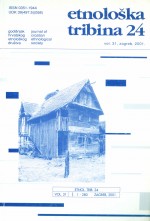Neiskaziv ples i nevidljiva žena. Neka razmišljanja o plesu u lastovskom pokladu
Unexpressable Dance and Invisible Woman. Some Thoughts about Dance in the Lastovo Carnival
Author(s): Iva NiemčićSubject(s): Theatre, Dance, Performing Arts, Gender Studies, Cultural Anthropology / Ethnology
Published by: Hrvatsko etnološko društvo
Keywords: dance; gender/sex; carnival;
Summary/Abstract: The first issue to raise is how to write about dance at all? Since dance is primarily a physical act, the dance researchers face numerous problems when wanting to textualize or write down the dance steps, for, according to Frykman, the silent knowledge about human lives cannot be transferred into a text without losing important dimensions (Frykman 1990: 82). Therefore, were we to use the already existing dance notation systems, we would be able to note merely the dance structure, leaving the stylistic performance, subjective impression and atmosphere unexpressable. The second part of the paper deals with the marginal phenomena of the carnival (poklad) of the island of Lastovo. Two processions go through the village on the Shrove Tuesday: the male procession of pokladari and the female procession named lovely masquers (lijepe maškare). Regardless of their similar size, as well as the identical way they take through the village, those two groups have different treatment in literature: the procession of lovely masquers has been put at the margins of this rich and picturesque happening. My fieldwork experience has provided me with a part of the explanation. Following the instructions given by the main organizers of the carnival, I have followed the pokladari procession, being the one responsible for the more important moments of the carnival, such as procession through the village with the Poklad doll on a donkey, culjanje and finally the carnival round dance (pokladarsko kolo) and burning of Poklad. Having returned to Zagreb, I have realized that I have only managed to see what the pokladari procession was doing on that Tuesday, running through the village after them. The procession of lovely maskers has remained in the distance, since those two processions must never meet. I became aware of not getting any information on the lovely maskers by following the instructions of the people who are the best authorities on the carnival and its history. I assume that something similar had happened to the scholars who did their research projects on the Lastovo carnival before me. It should be also mentioned that the scientific discourse of the middle of the second half of the twentieth century almost did not perceive a woman as a subject of a study, and it is probably also not by coincidence that all researchers into the Lastovo carnival who have left a written documents after them were men. Furthermore, the fact that the lovely masquers wear new and different masks every year and that this procession is glamorous should not be overlooked as well. This differentiates lovely masquers from the pokladari procession, and it may also be one of the reasons for those masks not being interesting to the researchers of traditional culture. Next year, I have followed the procession of the lovely masquers and it was then that I get to know about the similarities and diversity of their part of this custom. And had I not personally witnessed to their omnipresence and parallel existence within the custom I would myself probably write exclusively about the pokladari procession and their round dance. The lovely masquers, although not been given the leading role and thus tagging after the pokladari procession, are still the decisive and crucial part of the whole happening.
Journal: Etnološka tribina : Godišnjak Hrvatskog etnološkog društva
- Issue Year: 31/2001
- Issue No: 24
- Page Range: 21-34
- Page Count: 14
- Language: Croatian

